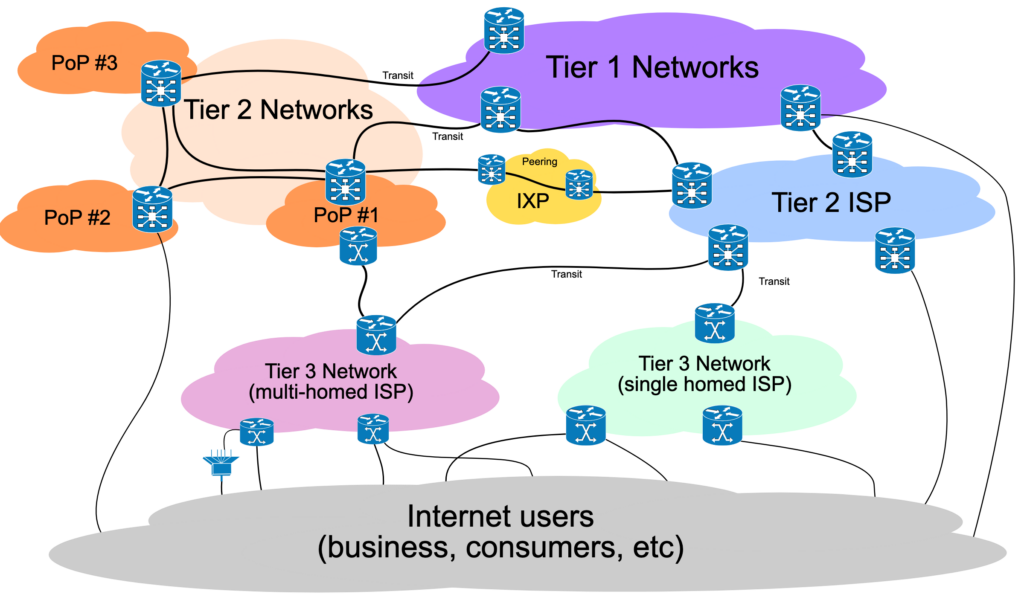A Tier 1 network provider operates a large global network infrastructure and provides transit services to other Internet Service Providers.
They are the major backbone networks that interconnect countries, and continents and enable worldwide Internet connectivity.
Tier 1 providers own and operate massive fiber optic networks spanning tens of thousands of miles. They peer with each other to exchange traffic without payments.
Some key capabilities of Tier 1 networks include seamless global reach, high network availability, low latency performance, and massive bandwidth capacity.
Leading companies that operate Tier 1 network infrastructures include Level 3 Communications, NTT, AT&T, Verizon, and Sprint.
Tier 1 networks form the core foundation that supports the functioning of the worldwide Internet.

Tier 1 Network Infrastructure
Tier 1 providers build and maintain extremely large and robust network infrastructures spanning multiple countries and continents.
1. Global Fiber Optic Network
- Tens of thousands of miles of fiber optic cables.
- Terrestrial networks and undersea cables.
- Connecting major cities and countries worldwide.
2. High Capacity Routers and Switches
- Advanced IP routers handle massive traffic.
- High-speed optical and Ethernet switches.
- Redundant equipment for reliability.
3. Points of Presence (PoPs)
- Co-location facilities are distributed globally.
- House routing/switching equipment.
- Interconnection points for networks.
4. Network Operations Centers
- Managing network infrastructure 24/7.
- Monitoring and controlling equipment.
- Managing faults, performance, and security.
Tier 1 Provider Peering
Tier 1 providers peer directly with each other to exchange Internet traffic.
1. Peering Relationships
- Tier 1 providers peer together freely.
- They do not pay each other for interconnecting.
- Agree to exchange roughly equal traffic volumes.
2. Public Peering Locations
- Internet Exchange Points (IXPs).
- Carrier-neutral co-location facilities.
- Peering policies are open and public.
3.Private Peering
- Some peering via private dedicated connections.
- Provides high-capacity interconnects.
- Enables direct efficient traffic exchange.
Peering enables global reach by allowing Tier 1 providers to share traffic destined for their respective networks and customers.
Services Offered by Tier 1 Providers
Tier 1 providers offer high-capacity Internet transit and transport services to carriers, ISPs, businesses, and content providers.
Internet Transit
- Provides access to the global Internet.
- Service providers can connect networks globally.
Wavelength, Ethernet Transport
- High-speed point-to-point data connections.
- For connecting data centers, and office locations.
IP Transit for VoIP Services
- Enables global VoIP phone and SMS connectivity.
- Underlies international voice communication.
Content Delivery Network (CDN)
- Distributed cache servers for faster content delivery.
- Improves performance for sites and apps.
Leading Tier 1 Network Providers
Some leading companies operating major Tier 1 global networks:
- Level 3 Communications (CenturyLink)
- NTT
- AT&T
- Verizon
- Sprint
- Deutsche Telekom
- Telia Carrier
These networks fulfill a vital role in interconnecting countries and networks to deliver the Internet globally.
Challenges Faced by Tier 1 Providers
Tier 1 providers have to overcome some key challenges in maintaining global networks:
- Requires enormous infrastructure investments.
- Building networks across continents is logistically complex.
- Obtaining right-of-way for laying new cables is tedious.
- Managing end-to-end performance over vast distances.
- Securing infrastructure from cuts, and network attacks.
- Upgrading network to stay ahead of bandwidth growth.
- Competing with other Tier 1 providers.
The Future of Tier 1 Networks
Tier 1 networks will evolve to meet growing technology demands:
- Leveraging software-defined infrastructure.
- Support for 5G and upcoming 6G networks.
- Distributing webscale infrastructure globally.
- Connecting billions of devices to the Internet.
- Using AI/ML to optimize complex networks.
- Automating network operations and management.
- Adopting greener technologies to reduce energy consumption.
The Tier 1 networks will continue to serve as the critical foundation of the global Internet.
Frequently Asked Questions (FAQ)
Ques 1. How many Tier 1 networks exist in the world?
Ans. There are about a dozen major companies operating Tier 1 carrier networks globally. Some well-known ones include AT&T, NTT, Verizon, Deutsche Telekom, and Level 3.
Ques 2. What makes a network Tier 1?
Ans. Owning a large international network infrastructure, peering directly with other Tier 1s, not paying for transit, and selling transit services to smaller ISPs are defining attributes of a Tier 1 network.
Ques 3. Are Tier 1 networks more reliable than lower tiers?
Ans. Yes, Tier 1 providers invest heavily in network robustness and redundancy. With no upstream transit dependency, Tier 1s offer greater reliability.
Ques 4. How long does it take to build a global Tier 1 network?
Ans. It requires tremendous long-term investment and takes decades of planning and building infrastructure to construct a Tier 1 network spanning multiple continents.
Ques 5. Does data take the shortest path between Tier 1 networks?
Ans. Not necessarily. Traffic routes along the lowest cost path based on peering agreement.
However But ingress and egress points are optimized for shortest path connectivity.






